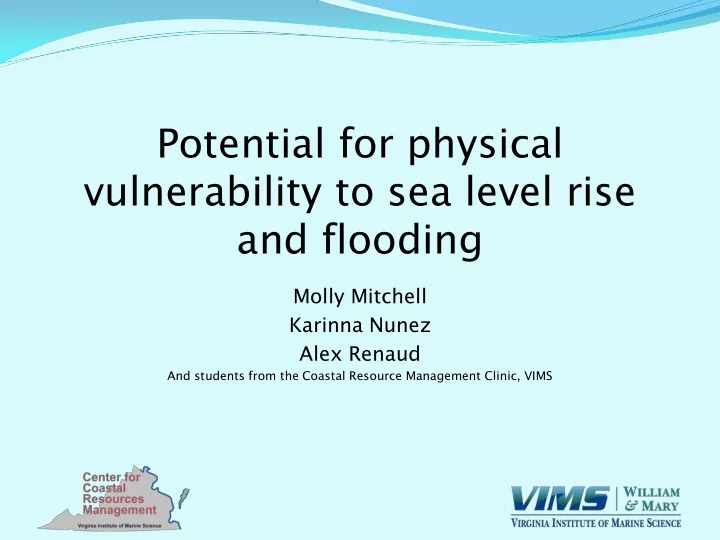

Potential for physical vulnerability to sea level rise and flooding Molly Mitchell Karinna Nunez Alex Renaud And students from the Coastal Resource Management Clinic, VIMS
Tidal and Storm surge flooding is influenced by… Tidal cycles • Elevation • Storm Characteristics • (pressure systems) Natural shoreline • Marsh – Beach – Shoreline stability • (erosion potential) Local and global water • levels
Tidal and Storm surge flooding is influenced by… Tidal cycles • Elevation • Storm Characteristics • (pressure systems) Natural shoreline • Marsh – Beach – Shoreline stability • (erosion potential) Local and global water • levels
Characterizing Vulnerability at the tract level Thieler and Hammar-Klose McLaughlin et al. 2010 Kleinosky et al. 2006 Torreson et al. 2008 Frazier et al. 2010 Gornitz et al 1994 Balica et al. 2012 Clark et al. 1998 Literature Principal Physical Vulnerability Indicators Wu et al. 2002 This Study 1999 Elevation Geology Geomorphology Tidal Range Wave Height/Characteristics Storm Freq/Probability Coastal slope SLOSH flood model Distance from Shore Storm Intensity Relative SLR/Subsidence Shoreline erosion/accretion Storm Surge Rivers Present/Discharge FIRM Map Flood Exposure Wetland Presence Coastline Length Fetch Developed Land
Our index of physical vulnerability was developed using high resolution LIDAR data to create a digital relief map of the coastal Chesapeake Bay region in ArcGIS. Two measures: 1. Tracts with elevations below 10 ft 2. The volume to surface area ratios (what percentage of the tract is low elevation) Map by Julie Herman, VIMS
Land cover below 10 ft in elevation (natural areas and wetlands provide buffers to storm events decreasing vulnerability). In order to analyze land cover across the region, Coastal Change Analysis Program (C-CAP) data was downloaded from the National Oceanic and Atmospheric Administration (NOAA) Coastal Services Center. For this study, 2010 C-CAP data for Virginia and Maryland was used. Data was reclassified into 4 different land cover types: Agriculture, Developed Areas, Natural Nontidal Areas, and Wetlands
Fetch component was calculated using the Virginia Exposure Model generated by the Coastal Resources Management – VIMS. Fetch was determined in 16 • directions for points every 50 to 100m along the tidal shoreline. For this study, a spatial model • Short fetch was generated to calculate the ratio of shoreline with high exposure over the total shoreline per census tract. Long fetch
Tide range 4 Big tide range 3 Height above normal high tide 2 1 0 0 5 10 15 20 -1 -2 -3 -4 4ft tide range storm 4 Small tide range 3 2 Height above normal high tide 1 0 0 5 10 15 20 -1 -2 -3 -4 2ft tide range storm Layer created by Shoreline Studies Program, VIMS
Physical vulnerability by census tract elevations below 10 ft + volume to surface area ratios + Land cover below 10 ft + Fetch + Low Tide Range High
Storm experience Past history may give some indication of the vulnerability of an area to future storm events. However, storm tracks change with changing ocean dynamics, making it difficult to predict the relationship between past and future storm history.
Are there areas where both physical and social vulnerability indices coincide to make certain areas the most vulnerable? Areas of high physical vulnerability on an example SOVI map
Conclusions • This index helps to rank areas by their susceptibility to flooding • The index is relative, so can be re-done at different scales to be relevant to different policy units • It can be used to target areas with high vulnerability for mitigation efforts • It can be combined with other indices to find the highest risk socio-economic populations which are also most threatened by flooding
Recommend
More recommend